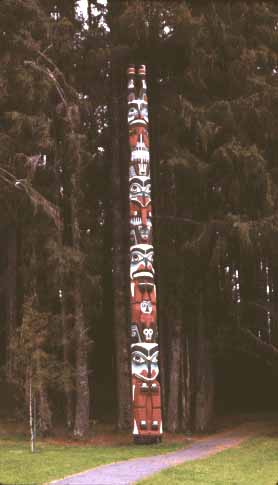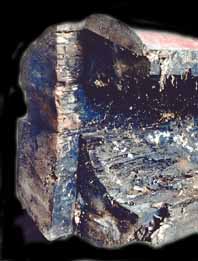Proper preservation treatments and regular maintenance are essential for effective protection of exterior woodwork.
PRESERVATION
Tech Notes
EXTERIOR WOODWORK
NUMBER 4Protecting Woodwork Against Decay Using Borate Preservatives
Ron Sheetz
Division of Conservation
Harpers Ferry Center
National Park ServiceCharles Fisher
Heritage Preservation Services
Technical Preservation Serfices
National Park Service
TOTEM POLES
Sitka National Historical Park
Sitka, Alaska
Introduction
Totem poles (totems) generally serve one of four purposes: crest poles , such as the Yaadaas Crest Pole shown to the left, give the ancestry of a particular family; history poles record the history of a clan; legend poles illustrate folklore or real life experiences; and memorial poles commemorate a particular individual. The first recorded sightings were by European explores and traders in the late 18th century and detached exterior poles reached their zenith in the late 19th century, standing along the village fronts of the Haida and Tingit Indians of northern British Columbia and extreme southeast Alaska.
The totem pole collection at Sitka National Historical Park embodies the rich carving traditions--past and present--of Southeast Alaskan Natives. Started in the early 1900s, the collection was one of the significant factors for the park's designation as a National Monument in 1910. Deterioration of the poles' in-ground wood due to fungal decay necessitated making new base supports for seven poles. As part of the project, the carvings on the red cedar poles were treated with a borate wood preservative in order to protect them against fungal decay and insect damage. This treatment has broad potential applicability for the preservation of exterior woodwork on structures, site features and objects.
Severe decay of the totem is shown here, prior to treatment.Problem
Famous as the capital of Russian-America and the home of the Tlingit Indians, Sitka is located along the southeast coast of Alaska. It has a relatively mild, yet very moist, climate with more than 95 inches of rainfall annually. The famous outdoor totem pole collection at the national park has suffered from the effects of moisture throughout much of the twentieth century. The most serious fungal decay recently encountered occurred at the base of the poles, although fungal growth and structural problems, including splits and cracks, were prevalent on the above-ground carvings as well.
Replicating poles at Sitka for ourdoor display is a treatment practiced at the park as early as the 1930s. However, re-carving inevitably results in the loss of the original craftsmanship as well as the original artistic expression. Today, the National Park Service strives to extend the life of the totems for outdoor display as long as possible. Most of the older original totems that have survived have been relocated indoors for exhibit or storage because of their significance and condition. The older replicas and the more recently carved new totems are generally being maintained and conserved for outdoor display.
Site Map
![]()


